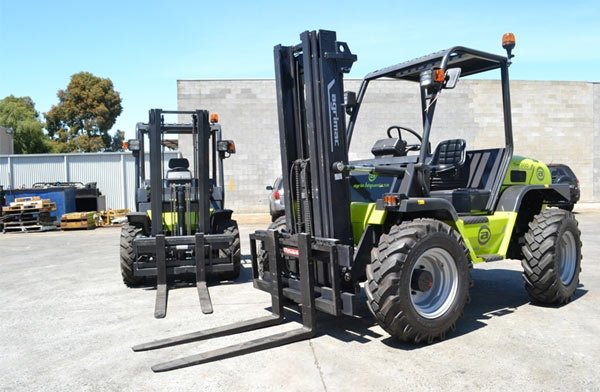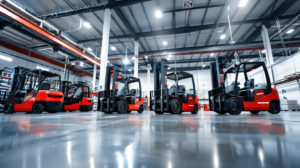Forklifts are essential machines for material handling, commonly found in warehouses, construction sites, shipping yards, and factories. They are designed to lift, carry, and transport heavy loads over short distances. However, there isn’t a one-size-fits-all forklift. Instead, there are many types, each suited to specific tasks, environments, and industries. Understanding the different types of forklifts will help you choose the right one for your operation, optimizing efficiency and safety.
In this article, we’ll explore the various types of forklifts, their unique features, and common applications. We’ll also provide insight into how to select the right forklift for your needs and recommend a trusted brand—Nicosail—for those looking to invest in reliable, high-quality forklifts.

1. Counterbalance Forklifts
Overview:
The counterbalance forklift is one of the most widely used types of forklifts. Its design features a weight in the rear of the machine that balances the load being carried on the front forks, which is how it gets its name.
Key Features:
- A simple and straightforward design
- Able to handle a wide range of weights and sizes of loads
- No extending arms, allowing the forklift to drive up to the exact location of the load
- Available in electric, gas, or diesel models
Best Applications: Counterbalance forklifts are incredibly versatile, commonly used in both indoor and outdoor settings. They are ideal for warehouse applications, loading docks, and distribution centers where maneuverability is crucial.
2. Reach Forklifts
Overview:
Reach forklifts, also known as reach trucks, are specialized for high-reach applications in narrow aisles. These forklifts are specifically designed to extend their forks forward, allowing operators to reach higher shelves in warehouse settings.
Key Features:
- High lifting heights with deep-reaching capabilities
- Excellent maneuverability in tight spaces
- Built with an open compartment to provide operators with maximum visibility
Best Applications: Reach trucks are best suited for indoor operations, particularly in warehouses with high racking systems. Their ability to reach greater heights makes them essential in large-scale storage operations.
3. Pallet Jacks (Manual and Electric)
Overview:
Pallet jacks are smaller, more compact material-handling equipment, typically used to move pallets over short distances. They come in both manual and electric versions, making them highly convenient for lightweight tasks.
Key Features:
- Simple controls for easy operation
- Small, compact size allows use in confined spaces
- Manual pallet jacks are hand-operated, while electric pallet jacks are battery-powered
Best Applications: Pallet jacks are commonly used in small warehouses, retail environments, or anywhere that pallets need to be moved short distances. They are ideal for low-weight loads and scenarios where full-sized forklifts would be impractical.

4. Telehandlers (Telescopic Forklifts)
Overview:
Telehandlers, or telescopic forklifts, combine the features of a forklift with a crane. These machines have a telescopic boom that allows for lifting loads both vertically and horizontally, making them extremely versatile.
Key Features:
- Telescopic arm that can reach forward and upward
- Ability to attach different tools such as forks, buckets, and grapples
- Off-road capability with large tires and robust suspension
Best Applications: Telehandlers are often used in construction, agriculture, and other outdoor industries. Their ability to lift materials to higher places and across obstacles makes them invaluable in outdoor settings with rough terrain.
5. Rough Terrain Forklifts
Overview:
Rough terrain forklifts are designed for outdoor use, particularly in challenging environments like construction sites, farms, or uneven surfaces. These machines are built with large, sturdy tires and enhanced suspension systems for better stability.
Key Features:
- Large pneumatic tires for superior traction
- Powerful engines, often diesel, to handle difficult terrain
- Reinforced bodies designed to withstand harsh conditions
Best Applications: These forklifts excel in rugged environments where traditional forklifts would struggle. Construction sites, lumberyards, and outdoor material-handling tasks are common places where rough terrain forklifts thrive.

6. Order Pickers
Overview:
Order pickers are forklifts specifically designed for selecting individual items from racking systems, rather than moving entire pallets. Operators are lifted with the forks to retrieve items stored on higher shelves.
Key Features:
- Operator platform lifts with the forks to access high shelves
- Great for picking individual items, rather than entire pallets
- Available in various heights and lifting capacities
Best Applications: Order pickers are frequently used in large warehouses and distribution centers where items are stored on high racks. They are essential for industries that deal with high-volume order fulfillment, such as retail or e-commerce.
7. Warehouse Forklifts
Overview:
Warehouse forklifts are designed specifically for indoor use in environments like warehouses and factories. These forklifts are used for loading and unloading delivery trucks, stacking goods, and transporting pallets within confined spaces.
Key Features:
- Compact size for tight spaces
- Electric models are common for indoor operations due to lower emissions
- Easy maneuverability in warehouse aisles
Best Applications: As the name suggests, warehouse forklifts are best suited for warehouses, manufacturing plants, and indoor storage facilities. They are highly efficient for stacking pallets and moving loads in controlled environments.

8. Side Loader Forklifts
Overview:
Side loader forklifts are unique in that the operator sits in a sideways-facing cabin, and the forks are mounted to the side of the vehicle. This allows for easy handling of long or awkwardly shaped loads.
Key Features:
- Forks extend out to the side, rather than the front
- Perfect for narrow aisles and tight spaces
- Designed for lifting long or oversized materials like timber or pipes
Best Applications: Side loaders are commonly used in industries that deal with long or bulky items, such as lumber yards, steel mills, and construction materials suppliers. Their design allows for efficient loading and unloading in narrow aisles.
9. Articulated Forklifts
Overview:
Articulated forklifts are designed with a pivot point in the center, allowing the front of the machine to swivel. This feature makes them highly maneuverable in tight spaces, especially narrow aisles in warehouses.
Key Features:
- Highly maneuverable with the ability to turn in narrow spaces
- Ability to operate in both wide and narrow aisles
- Front forks rotate to pick and place loads efficiently
Best Applications: These forklifts are ideal for indoor warehouse operations where space is limited. Their ability to navigate tight spaces without sacrificing lifting power makes them popular in storage facilities with narrow aisles.

10. Industrial Forklifts
Overview:
Industrial forklifts are heavy-duty machines built for carrying extremely heavy loads over long distances. These forklifts are larger and more powerful than typical warehouse forklifts, designed to handle industrial-scale jobs.
Key Features:
- High weight capacities
- Larger size and more powerful engines
- Built for long-distance load carrying
Best Applications: Industrial forklifts are essential in environments where extremely heavy materials need to be transported, such as manufacturing plants, shipping yards, and large distribution centers.
11. Container Handlers
Overview:
Container handlers are specialized forklifts designed for lifting and stacking shipping containers. They are commonly found in ports, shipping terminals, and container yards.
Key Features:
- Can lift heavy shipping containers and stack them several units high
- Equipped with strong, durable lifting arms
- High weight capacity for handling oversized loads
Best Applications: These forklifts are essential for operations in the shipping industry, particularly at ports and distribution centers where containers need to be moved quickly and efficiently.
12. Turret Trucks
Overview:
Turret trucks are designed to maximize storage space in warehouses with narrow aisles. These forklifts have rotating forks that allow the operator to access loads without turning the entire machine.
Key Features:
- Forks can rotate up to 180 degrees
- Built for narrow-aisle applications
- Operator is elevated with the forks for easy load access
Best Applications: Turret trucks are best used in high-density storage facilities where space is at a premium. Their ability to access loads in tight spaces without needing to reposition the forklift makes them highly efficient for maximizing storage capacity.
13. Walkie Stackers
Overview:
Walkie stackers are pedestrian-operated forklifts, meaning the operator walks behind or alongside the machine while controlling it. They are smaller than traditional forklifts but can lift loads to higher elevations than a pallet jack.
Key Features:
- Compact and easy to maneuver
- Electric-powered for quiet, emission-free operation
- Ideal for light to moderate lifting
Best Applications: Walkie stackers are commonly used in small warehouses, retail stores, and distribution centers where full-sized forklifts are too large or powerful for the task. They are great for stacking pallets in low- to mid-level racking systems.
14. Heavy-Duty Forklifts
Overview:
Heavy-duty forklifts are designed to handle exceptionally heavy loads, often exceeding 30,000 pounds. These machines are used in industries where heavy materials, like steel, concrete, or large containers, need to be moved.
Key Features:
- Extremely high load capacity
- Reinforced frames and powerful engines
- Often equipped with specialized attachments for specific tasks
Best Applications: Heavy-duty forklifts are crucial in industries like steel manufacturing, shipbuilding, and heavy construction, where typical forklifts would be inadequate.

15. Electric Forklifts
Overview:
Electric forklifts are powered by rechargeable batteries rather than combustion engines. They are quiet, emission-free, and ideal for indoor use where air quality and noise control are concerns.
Key Features:
- Rechargeable battery power
- Zero emissions, making them eco-friendly
- Typically smaller and more agile
Best Applications: Electric forklifts are widely used in indoor environments like warehouses and manufacturing plants where noise reduction and emissions are critical factors. They are ideal for indoor material handling, offering an environmentally friendly option.
Choosing the Right Forklift for Your Needs
Selecting the right forklift depends on various factors such as the weight of the loads, the terrain, the height requirements, and the operational environment. For indoor use, electric forklifts or warehouse forklifts are optimal due to their maneuverability and quiet operation. For outdoor or rugged environments, telehandlers or rough terrain forklifts offer the necessary power and stability.
Why Choose Nicosail for Your Forklift Needs?
When it comes to purchasing a forklift, you want a brand that combines innovation, durability, and reliability. Nicosail is an industry leader known for its wide range of high-quality forklifts that cater to various industries. Whether you need an electric forklift for a warehouse or a telehandler for construction, Nicosail offers a robust selection of machines that are built to last.
Nicosail forklifts are designed with cutting-edge technology, ensuring maximum efficiency and safety. Their commitment to quality and customer satisfaction makes them a trusted choice for businesses around the world. Investing in a Nicosail forklift means investing in long-term performance and reliability.





